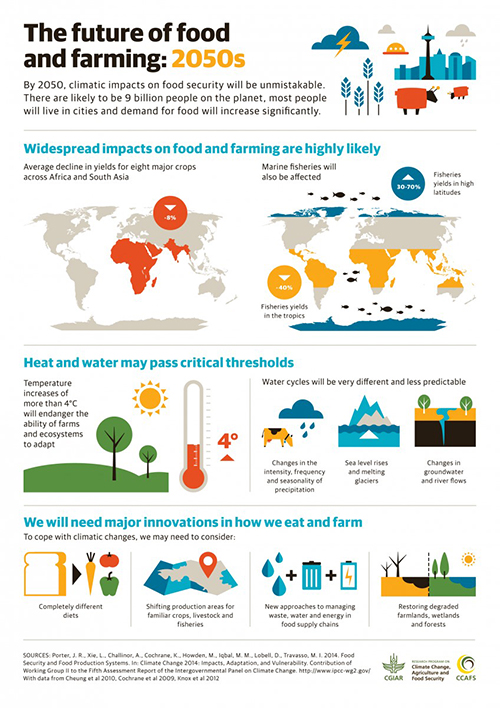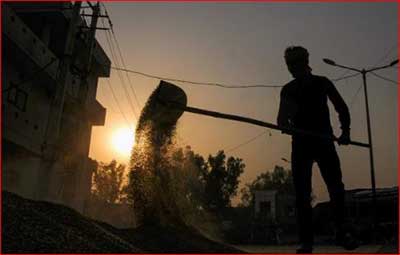Relevance: GS-3: Major crops-cropping patterns in various parts of the country, food security.
Key Phrases: Russia’s invasion, World Weather Attribution Group, Indian Meteorological Department, blistering heatwave, Mean Precipitation, rain-fed agriculture.
Context:
- Russia’s invasion of Ukraine has gummed up supply chains and sparked shortages of everything from wheat to barley and edible oils and also fertilizer threatening food security.
Key Highlights
- Russia and Ukraine account for nearly one-third of the world’s wheat exports. The more profound, long-term worry is climate change and what will happen to crops and food self-sufficiency as the mercury rises.
- The World Weather Attribution Group (WWAG), offered grim predictions about future heatwaves in the subcontinent.
- The Indian Meteorological Department had already declared March the hottest since record-keeping began 122 years ago.
- Temperatures were consistently 3° C - 8° C above average, breaking many decadal and some all-time records in several parts of the country.
- In Pakistan, Jacobabad recorded 49° C on April 29 and India experienced around 300 forest fires around the same time.
- Alarmingly, the report concluded extreme weather events, once thought to occur once-in-100 years, are now 30 times more likely than before (or between every three-to-five years).
- What’s equally alarming is March was also one of the driest recorded, and April’s rainfall was also way below normal in north India’s crop-growing regions.
- In parts of Kerala, by contrast, unseasonal rains forced cultivators to wade through watery fields to harvest paddy. Again, the result was a reduced, low-quality crop.
- Crop yields are down by 20 percent and that led to the government withdrawing its offer to “feed the world” and slamming the brakes on wheat exports.
Do you know?
- The Global Hunger Index (GHI) is a tool that measures and tracks hunger globally as well as by region and by country, prepared by European NGOs of Concern Worldwide and Welthungerhilfe.
- The GHI is calculated annually, and its results appear in a report issued in October each year.
- In the 2021 Global Hunger Index, India ranks 101st out of the 116 countries with sufficient data to calculate 2021 GHI scores.
- With a score of 27.5, India has a level of hunger that is serious.
Impact of Climate Change on Food Security
- Climate change will affect all four dimensions of food security: food availability, food accessibility, food utilization, and food systems stability.
- Mean Temperature:
- Average temperatures are expected to increase across the globe in the coming decades.
- In mid-high latitudes, increasing temperatures can have a positive impact on crop production, but in seasonally arid and tropical regions, the impact is likely to be detrimental.
- Mean Precipitation:
- On average, an increase in global precipitation is expected, but the regional patterns of rainfall will vary: some areas will have more rainfall, while others will have less.
- There are high levels of uncertainty about how the pattern of precipitation will change, with little confidence in model projections on a regional scale.
- Areas that are dependent on seasonal rainfall, and those that are highly dependent on rain-fed agriculture for food security, are particularly vulnerable.
- Extreme Events:
- Recurrent extreme weather events such as droughts, floods and tropical cyclones worsen livelihoods and undermine the capacity of communities to adapt to even moderate shocks.
- This results in a vicious circle that generates greater poverty and hunger.
- The impacts on food production of extreme events, such as drought, may cancel out the benefits of the increased temperature and growing season observed in mid to high latitudes.
- Drought:
- Meteorological drought (the result of a period of low rainfall) is projected to increase in intensity, frequency and duration.
- Drought results in agricultural losses, reductions in water quality and availability, and is a major driver of global food insecurity.
- Droughts are especially devastating in arid and semi-arid areas, reducing the quantity and productivity of crop yields and livestock.
- Heat Waves:
- Events that are considered extreme today will be more common in the future.
- Changes in temperature extremes even for short periods can be critical, especially if they coincide with key stages of crop development.
- Heavy Rainfall and Flooding:
- There will be more heavy rainfall events as the climate warms.
- Heavy rainfall leading to flooding can destroy entire crops over wide areas, as well as devastating food stores, assets (such as farming equipment) and agricultural land (due to sedimentation).
- Melting Glaciers:
- Melting glaciers initially increase the amount of water flowing in systems and enhance the seasonal pattern of flow.
- Ultimately, however, the loss of glaciers would cause water availability to become more variable from year to year as it will depend on seasonal snow and rainfall, instead of the steady release of stored water from the glacier irrespective of that year’s precipitation.
- Tropical Storms:
- For many arid regions in the Tropics, a large portion of the annual rain comes from tropical cyclones.
- Tropical cyclones also have the potential to devastate a region, causing loss of life and widespread destruction to agricultural crops and lands, infrastructure, and livelihoods.
- Some studies suggest tropical cyclones may become more intense in the future with stronger winds and heavier precipitation.
- Sea-Level Rise:
- Increases in mean sea level threaten to inundate agricultural lands and salinize groundwater in the coming decades and centuries.
- Sea-level rise will also increase the impact of storm surges which can cause great devastation.
- Changes in Health and Nutrition:
- Climate change has the potential to affect different diseases, including respiratory illness and diarrhea.
- Disease results in a reduced ability to absorb nutrients from food and increases the nutritional requirements of sick people.
- Poor health in a community also leads to a loss of labor productivity.

Way Forward: Recommendations
- Adoption of sustainable agricultural practices:
- Agricultural policy should focus on improving crop productivity and developing safety nets to cope with the risks of climate change.
- Better management of water resources must be a key feature of sustainable agriculture.
- Enhance livelihood security:
- Achieving food security in the context of climate change calls for an improvement in the livelihoods of the poor and food-insecure to not only help them escape poverty and hunger but also withstand, recover from, and adapt to the climate risks they are exposed to.
- Greater emphasis on urban food insecurity:
- Urban India is not only an important contributor to global greenhouse gas emissions but also a victim of climate change as poor people account for the bulk of its population.
- As observed earlier, climate change will have an enormous impact on urban food insecurity.
- Need for more impact assessment studies:
- To develop climate-resilient strategies and make adequate policy interventions, there is a need for an integrated assessment of the impact of climate change on India’s food security.
Conclusion:
- With progress made on renewable installations, adoption of electric vehicles and government setting its sight on turning India into a green energy powerhouse, we’re making a start.
- We have the urgent need to lift millions out of poverty. It’s not an easy circle to square but we must address it now or declining agricultural productivity and resulting higher food prices will mean more economic hardship, not less.
Sources: The Hindu BL
Mains Question:
Q. How climate change is impacting food security in the world? Suggest suitable ways forward to mitigate it. (250 words).









